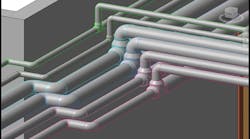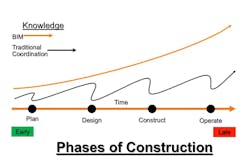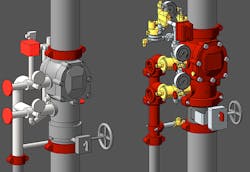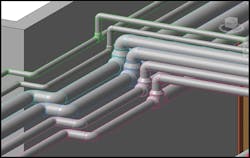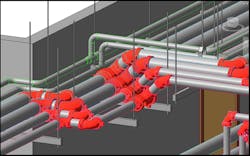Latest from Software
Software Showcase
Sponsored
In my job as BIM Manager for the Construction Piping Services department at Victaulic, I work with many contractors who know all there is to know about Building Information Modeling (BIM) … and I work with some that could use a few pointers. BIM has evolved in the past few years, and continues to evolve with more and more projects having BIM requirements.
Contractors able to meet those requirements may find they have a competitive advantage over those who can’t. For that latter group, fortunately, it’s never too late to learn. With that, let’s review the basics of BIM.
An overview
BIM is a process involving the creation and use of a digital representation of the physical and functional characteristics of a facility, according to the National BIM Standard Project Committee. It is “a shared knowledge resource for information about a facility forming a reliable basis for decisions during its lifecycle,” meaning from conception to demolition.
The BIM process allows all stakeholders to utilize a single model to design, construct and operate a building. The design stage includes conceptual design, detailed design and analysis (energy analysis, for example). In the build stage, contractors can create construction documentation based on the detailed design, which is used for fabrication and construction. This stage also includes construction logistics and the physical construction of the facility. Once the facility is built, the owner can use the model to operate and maintain the building, as well as renovate and demolish, if necessary, in the future.
One of the misconceptions I often hear is reference to BIM as software. BIM is a process, not a software program. Certainly software is at the technological core of BIM, but that represents only about 10 percent of the system. The other 90 percent of BIM is sociology, including the work practices that utilize the software and shape social practices. As such, we refer to it as a sociotechnical system.
The technological base of BIM consists of 3D design, intelligent models and information management; social components include synchronous collaboration, coordinated work practices and a cultural or institutional framework in which BIM is incorporated in a company’s processes — workflow, for example — and business plan.
What BIM strives to do, in contrast to traditional coordination, is increase communication and collaboration at the front end of a project — it brings all stakeholders together earlier in the construction timeline.
In traditional coordination, contributors such as the architect, engineer, contractor, subcontractors, facility manager and client work in silos. Modeling and coordination is handled in offices and the information flows to the jobsite.
Change requests pass from the jobsite to the office and revisions get sent back. Quite often, the information is still on paper — not in the cloud or on an FTP site — and it’s duplicated many times. This work
flow increases the amount of late changes, driving up construction costs. It also leads to a two-steps-forward-one-step-back result as the baton is passed at each phase of a project, from plan to design to construct and, finally, operate. At the end of each phase to the beginning of the next, a loss of knowledge occurs that must be regained and grow beyond what it was (see figure 1).
In the traditional coordination process, communication between stakeholders peaks in the construction documentation phase which can affect progress on the jobsite.
The new approach alters workflows, so that communication peaks in the design and design development phases. At this stage, changes are much easier to make, they don’t slow or stop construction and costs are easier to control. This can reduce or eliminate litigation due to cost and schedule overruns. Under this new approach, contributors cannot work in silos. Instead, all parties are collaborating as the model is developed and working together to eliminate clashes.
Solving coordination issues virtually in the design phase is much more efficient and cost effective. It also improves safety and reduces labor on the jobsite. With all stakeholders involved from the outset, knowledge increases through each phase of a project — there is minimal loss of knowledge between phases.
BIM Terminology
Among the more common terms you’ll hear associated with BIM are level of development, level of detail and what’s known as the ‘Ds’ of BIM.
Level of detail and level of development are often confused, but there’s an important difference between the two. The level of detail refers to the detail put into the model elements/parts, also known as content; it is an input.
Take a valve for example. At a higher level of detail, you might see symbols or numbers on a gauge, while at a lower level you might simply see a circular-shaped object denoting a gauge (see figure 2). Both valves are serving the same purpose, taking up the same amount of space, there’s just more detail shown in one versus the other.
Level of development, or LOD, is how much the element’s geometry can be relied upon by users for processes such as energy analysis, clash detection, exporting reports, producing accurate bills of material (BOMs), and tracking submittals for maintenance. LOD is an output. Level of development, which can vary at different stages of design and construction, ranges from 100 to 500, with 500 being the most developed. Each level defines what the model can reliably be used for. Level 200 includes generic content that serves as a placeholder.
A fitting, for example, wouldn’t have proper dimensions, there would be no flow coefficients and it couldn’t be used to extract a bill of material (see figure 3). At level 400, that same element would identify the fitting manufacturer and model, it would take up the correct amount of space in the model and include details that could be used for energy analysis. Level 400 is a construction-level model that can be used for fabrication.
As for the ‘Ds’ of BIM, when engineers and contractors refer to 3D or 5D, for example, they’re referring to the ‘dimensions’ of BIM, including the model itself and what can be done with it. The number of dimensions has evolved over the years, with 3D through 7D most often recognized today.
4D refers to scheduling. A construction schedule can be created with the model, and project phasing simulations can help plan what will be installed when, as well as the sequence in which things will be installed. In addition to identifying physical clashes during coordination, software can be used to determine which trades are going to clash during installation to avoid delays on the job site. 4D also includes lean scheduling of procurement, which enables just-in-time deliveries to the job site or fabrication shop.
Contractors can essentially back-time construction and create a fabrication schedule and delivery plan to ensure equipment and materials arrive on the jobsite in the proper area of the building, bagged and tagged just in time for a labor-saving installation.
5D is estimating. At higher levels of development with intelligent content, the model can be used for real-time cost planning. Quantities can be extracted and detailed cost estimates created. 5D also enables value engineering and trade verification. Value engineering analyzes possible outcomes to determine the most efficient and cost-saving option.
Think of it as ‘what-if scenarios.’ For example, what if we evaluate efficiency and energy costs on two chiller plant designs, one using two large chillers and one using three smaller chillers with variable speed pumps? Initial installation costs and operating costs can be compared to select the most efficient design for the owner. Trade verification allows the general contractor and owner to use the model to verify estimates and costs for all subcontractors.
6D is sustainability. A conceptual energy analysis can be conducted early in the design phase, while detailed energy tests can be performed later in the design process. This can help reveal energy-saving alterations, for example, changing the angle of the building or the glass type to reduce cooling costs based on how the sun hits the building. If the project is aiming for LEED certification, sustainable elements can be tracked.
7D refers to facility management, in other words, use of the model for operation and maintenance of the building. The owner can be provided an intelligent 3D model file with embedded equipment and product submittals for quick reference when maintenance is required.
Through the Construction Operations Building Information Exchange (COBie), facility managers receive building data, not geometric modeling data, that allows them to track assets and warranties and develop preventative maintenance plans. This eases the traditional handover of paper construction documents that facility managers must then manually enter into a computerized maintenance management system (CMMS).
It’s important to note that, although the dimension numbers rise sequentially, they shouldn’t be considered stages of a project. Elements of 6D can be done at any point in a project; some of these procedures might be performed before the estimating tasks of 5D. 4D scheduling might occur hundreds of times throughout a project.
Benefits of BIM
BIM delivers numerous benefits to all stakeholders throughout the project lifecycle. Early collaboration and virtual coordination reduces rework and change orders that slow construction and increase costs. By simplifying material management and pre-planned deliveries, BIM helps contractors reduce jobsite hours, which can improve safety ratings. Ultimately, the early coordination and collaboration can compress the construction schedule, reduce overall construction costs and reduce or eliminate litigation.
BIM takes quite a bit of time, a lot of resources and even some sacrifice from a financial point of view. Contractors looking to add BIM capabilities will have to entertain reviewing and adjusting workflows and processes and potentially acquiring new computer hardware and software. There will be a lot of training required, and several new hires may need to be brought in. However, contractors that are able to meet BIM requirements are more competitive; they can win more projects and, in due course, make more money.
Jeff Leighton is the BIM Manager within the Construction Piping Services department at Victaulic, a manufacturer of mechanical pipe joining and fire protection systems. Jeff is a member of the Associated General Contractors of America (AGC) and the NBIMS-BIM Standard Subcommittee. He holds an AGC Certificate of Management-Building Information Modeling (CM-BIM). For more information, visit www.victaulic.com.


